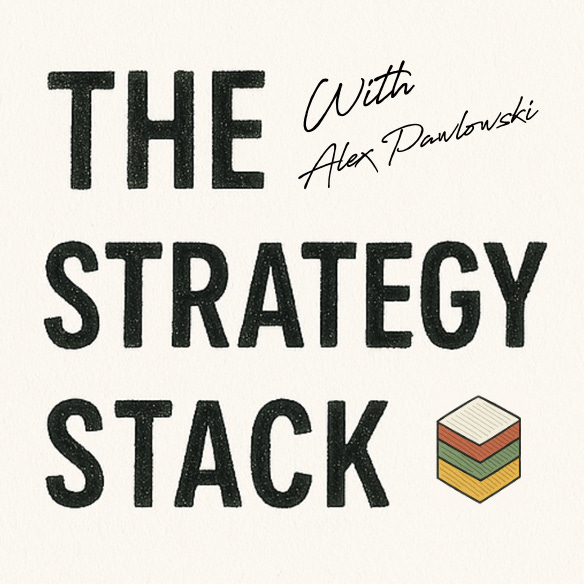👥 Featuring:
Host: Alex (The Strategy Stack)
Opening & Setup
Alex kicks off the third episode of his six-part live series based on his book Agentic Strategy: Leading Organizations That Think, Learn, and Act.
This session focuses on the Agentic Operating Model (AOM) — the foundational architecture organizations need to successfully scale AI agents.
Alex reflects on earlier sessions:
Part 1: Why companies fail with AI agents — common pitfalls like misaligned strategy, lack of stakeholder buy-in, and poor value-risk estimation.
Part 2: The shift from digital to cognitive transformation — showing how AI agents fundamentally change how businesses think and operate.
Today, Part 3 goes practical:
Alex breaks down the five layers of the AOM, explains how agents interact across systems, and shares best practices for building an organization that thinks and evolves dynamically.
He emphasizes that most AI failures aren’t technical — they result from a lack of coherent architecture, where isolated experiments (e.g., a chatbot, a demand-forecasting AI, a marketing recommendation engine) don’t connect or compound value.
Why Companies Fail with AI Agents
Reason 1: The Feature Trap – Mistaking AI for Strategy
Many organizations launch isolated AI features — "islands with no bridges" — without connecting them to a larger system.
These lack shared memory, feedback loops, and strategic integration, leading to short-lived ROI.
Example: A retailer launches a chatbot without escalation paths or evolution. It frustrates customers and eventually fails.
Counter-learning: Design for systems of intelligence, not collections of tools.
Louis Vuitton’s MAIA system connects 75 brands, compounding intelligence through interconnected feedback.
Digital Transformation 1.0 vs. 2.0
1.0: Linear, tool-based automation → digitizing processes for efficiency.
2.0: Agentic systems that interpret, reason, and act → requiring dynamic re-architecture.
Applying 1.0 thinking to 2.0 systems leads to failure.
Reason 2: Lack of Strategic Alignment
Many organizations fail to answer: “What is this intelligence for?”
Misaligned agents optimize irrelevant metrics or operate in silos.
Example: Success
Minotaur Capital’s Torient system encodes strategic goals like risk and liquidity into the agent’s decision-making, achieving 23.5% YTD returns.
Tools to ensure alignment:
Visualize and document processes.
RACI matrices to clarify roles and responsibilities.
Controlled access to sensitive data and systems.
Reason 3: Missing Feedback Loops
Without feedback, agents plateau — repeating tasks without learning or compounding value.
Example:
Success: Salesforce’s AgentForce learns from every customer interaction, continuously improving predictions and insights.
Failure: The failed chatbot that restarts every conversation from scratch, never evolving.
Solution:
Treat every agent action as data. Build real-time feedback loops to continuously improve performance.
Reason 4: Over-Control or Under-Control
Too much control: Micromanagement reduces agents to simple automation scripts.
Too little control: Runaway intelligence creates fast but wrong decisions.
Solution:
Modular oversight with distributed escalation paths and clearly defined boundaries — like expanding a child’s autonomy gradually.
Reason 5: Human Cognitive Overload
Sometimes the problem isn’t the agents — it’s overwhelmed humans.
Poorly designed agents add noise instead of clarity, bombarding teams with alerts and fragmented insights.
Solution:
Design agents that think alongside humans, surfacing priorities rather than drowning them in data.
Example: Specialized agent pods handling analysis, research, and execution to reduce leadership’s cognitive load.
The Path Forward: The Agentic Operating Model (AOM)
The AOM is the nervous system of an organization — connecting isolated agents into a thinking, adaptive network.
It is built on five interconnected layers. Skipping any one of them creates weaknesses that derail scaling efforts.
Layer 1: Strategic Intent Encoding
Encodes what agents should optimize for.
Without this, agents pursue whatever is easiest, often misaligned with company strategy.
Example:
A retailer encodes rules such as:Optimize profit margins.
Maintain a minimum customer satisfaction score of 8.0.
Comply with local pricing laws.
Best practices:
Translate objectives into explicit rules.
Include ethical constraints.
Update quarterly, like OKRs.
Layer 2: Memory Systems
Agents without memory cannot learn or improve.
Memory stores:
Historical decisions and results.
Customer histories.
Feedback from humans and other agents.
Example:
LVMH’s MAIA system shares intelligence across 75 brands, instantly learning from campaigns in Tokyo, Paris, Milan, and New York.Best practices:
Build shared memory early.
Use structured formats like knowledge graphs.
Make memory auditable for transparency.
Layer 3: Feedback Loops
Every agent action must generate measurable feedback.
Example: Fraud detection agent flags a transaction → if later deemed legitimate, that signal feeds back into the model.
Case Study Failure: IBM Watson for Oncology didn’t learn from doctors’ rejections, leading to mistrust and eventual shutdown.
Best practices:
Build real-time event tracking, not just monthly reports.
Define success metrics pre-deployment.
Assign weekly ownership to monitor trends.
Layer 4: Trust Layer
Humans won’t adopt agents without trust.
Trust layer enforces:
Transparency — explainable decisions.
Ethics — preventing harmful or biased actions.
Escalation triggers — routing high-risk decisions to humans.
Example:
Minotaur Capital allows agents to act autonomously under $10M trades but requires human approval beyond that threshold.
Best practices:
Build explainability from day one.
Conduct quarterly bias audits.
Document and share escalation rules.
Layer 5: Modular Oversight
Balances autonomy and control through risk-tiered actions:
Low risk: Fully autonomous.
Medium risk: Human review after action.
High risk: Human approval required first.
Example:
Pricing agent:<5% discount → auto-approved.
5-15% → weekly review.
15% → immediate human sign-off.
Case Studies
Failure: IBM Watson for Oncology
Goal: Revolutionize cancer treatment recommendations.
Outcome: Discontinued due to unsafe or irrelevant recommendations.
Reasons:
Misaligned training data (U.S.-centric).
No adaptive feedback loops.
Unrealistic promises created mistrust.
Lesson: Start local, build adaptive systems, manage expectations.
Failure: Amazon Recruitment Tool
Goal: Automate resume screening.
Outcome: Abandoned after discovering gender bias.
Reasons:
Historical bias baked into data.
Lack of early oversight.
Misaligned objectives (efficiency > fairness).
Weak feedback mechanisms.
Lesson: Embed fairness metrics, run regular audits, ensure transparency.
Key Takeaways
Design, don’t just deploy — AI must be part of organizational architecture.
Alignment matters — goals must be encoded and refined continuously.
Feedback drives growth — without it, systems stagnate.
Balance control — avoid both micromanagement and chaos.
Humans + agents — treat agents as infrastructure, not just faster workers.
Start small, scale smart — pilot, learn, expand gradually.
Hit subscribe to get it in your inbox. And if this spoke to you:
➡️ Forward this to a strategy peer who’s feeling the same shift. We’re building a smarter, tech-equipped strategy community—one layer at a time.
Let’s stack it up.
A. Pawlowski | The Strategy Stack











